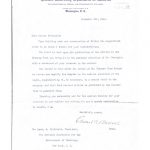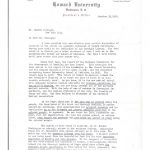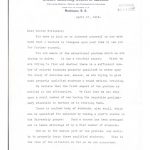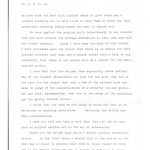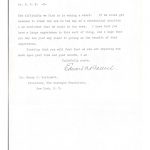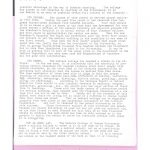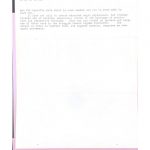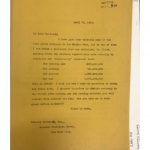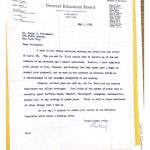Senior Lecturer at Flinders University’s College of Medicine and Public Health, Leïla Morsy visited the RBML as part of her work on The Medical Color Line, a project that examines how powerful philanthropies in the early twentieth century restructured medical education and underfunded Black medical schools, excluding Black doctors from the medical field and creating long-lasting legacies that persist today. Dr. Morsy talks about how these archival finds illuminate how the medical profession today can start to chart a path forward to redress the long-lasting effects of discrimination. You can read more about Dr. Morsy’s work in a recently published article, which incorporates her archival finds.
What brings you to Columbia’s Rare Book & Manuscript Library?
I am writing a book about the history of the exclusion of African Americans from medicine from the 1700s to today and its contemporary consequences. One inflection point in this history is the events following the publication of a 1910 report that suggested a revolution in American medicine. It became known by its author’s name: The Flexner Report. Today, the name is familiar to nearly all American doctors. The report argued that medical schools should have stronger admission standards, detailed and uniform accreditation requirements, that they be attached to teaching hospitals, and use medical curricula based in science and laboratory work.
The report also argued for the closing five of the seven Black medical schools. Abraham Flexner’s assessment of Black medical schools was scathing: “Of the seven medical schools for negroes in the United States, five are at this moment in no position to make any contribution of value.”1 They were “feeble, ill-equipped institutions” that were “wasting small sums annually and sending out undisciplined men, whose lack of real training is covered up by the imposing M.D. degree.”1(pp180-181) The report advised the two remaining Black medical schools, Meharry Medical College and Howard University School of Medicine, focus their curriculum on sanitation, hygiene, and preventative medicine rather than scientific medicine, in contrast to the scientific research ambitions the report laid out for white schools.1(pp180-181)
The report was funded by the Carnegie Foundation for the Advancement of Teaching, and co-developed with the American Medical Association. RBML maintains the Carnegie Foundation’s archives.
How long have you been using RBML materials (for this and/or previous research)?
I’ve made two multi-day visits to the RBML, both times to examine the Carnegie Foundation archives.
What have you found? Did you come here knowing this material was here?
Few schools, Black or white, had the money to meet the Flexner Report’s new standards for medical education. Funding for reforms suggested in the Flexner Report and adopted as standards for medical schools by the American Medical Association came from General Education Board. Established in 1902 with funding from John D. Rockefeller Sr., the General Education Board was a huge foundation with aims to restructure education and medicine. 2(pp389, 381),3(p121)
The General Education Board adhered to the Flexner Report guidelines and supported sweeping changes in medical education at white institutions but provided hardly any funding to the Black medical colleges towards scientific medicine, such as state-of-the art laboratories, new buildings, and salaries for staff to teach and research full time. Without General Education Board funding, Black medical schools struggled to raise necessary funds. At the time, the more affluent Black middle class was very small and not particularly wealth. Partly as a result, fundraising for Black institutions was slow and extremely modest. For example, one document in the Carnegie Foundation collection itemizes donations to Fisk University, another Black institution. A third were $5 or less.4
Particularly relevant to this part of the story are letters that illustrate the crisis developing in medical education, violated civil rights for African Americans, and the impending public health consequences.
Two letters from Edward Arthur Balloch, the Dean of Howard University School of Medicine to Henry Pritchett, the President of the Carnegie Foundation, are particularly relevant. In one 1911 letter, Balloch suggests that Flexner reinspect the Black medical schools, and that the Carnegie Foundation publish an updated assessment.5 Balloch hoped that a less critical evaluation would make it easier for Black medical schools to get philanthropic funding and survive. Flexner, or anyone else from the Carnegie Foundation, never did this.
In a second letter from 1913, Balloch explains to Pritchett why medical education for African Americans is important. He describes what Howard is trying to do to train the best doctors they can. And he asks Pritchett for advice: How can Howard’s School of Medicine attract philanthropic donations so that they can improve and expand? In 1913, Howard’s medical school graduated about 50 doctors a year,1 about a quarter of graduates of all other Black medical schools combined. Still, as Balloch implies, that wasn’t enough. In 1913, there were 10 million African Americans, largely excluded on the basis of race from most medical care.6
I haven’t found Pritchett’s response in the Carnegie Foundation archives, but what we do know is that for every dollar the General Education Board donated to Black medical schools between 1902 and 1919, white medical schools received $123. 7(p68) Between 1902-1920, the General Education Board disbursed over $3.3 million for white medical schools, more than 100 times the amount given to Black medical schools during the same period.8(p104) Howard had to wait until 1925 for GEB funding—$80,000 to match a federal grant to replace a decrepit building and purchase medical equipment.9(p904)
Another letter is telling. Wilbur Thirkield, the president of Howard, wrote to Andrew Carnegie just a few months after the publication of the Flexner Report.10 Thirkield diplomatically challenged the Flexner Report’s suggestion that Howard’s School of Medicine (and Meharry Medical College) focus on sanitation and hygiene over scientific medical training, which involved training doctors who also did research: “As the Negro physician is the only man of scienceamong his people, the importance of his broad and thorough training in modern scientific knowledge, with opportunities for original research and investigation as to the diseases and general physical condition of the colored people, is apparent.”10 Thirkield’s letter shows the opposition to the Flexner Report’s proposition that Black doctors be relegated to public health work. The letter also alludes to the increasing exclusion of African Americans from northern medical schools.
By August 1918, eight years after the publication of the Flexner Report, there were just three Black medical schools left. Two were Meharry and Howard. By 1922, graduates from the third remaining Black medical school, the University of West Tennessee Medical Department, were locked out of practicing in 46 states and all but irrelevant to the Black medical workforce.11(p652) The yearly number of black medical graduates had dropped by 33 percent as the Black population had increased by six percent.12(p15)
What have you found that’s surprised or perplexed you?
I should not have been surprised to find that the program officers at the Carnegie Foundation and the General Education Board not only knew each other, but were friends. They collaborated—co-developing funding programs, asking each other for advice, but also occasionally writing silly letters to each other.13,14 These letters show the level of familiarity between the heads of the two foundations, and how much power they knew they had.
What advice do you have for other researchers or students interested in using RBML’s special collections?
First, I better understood the documents I read in the Rare Books and Manuscripts Library’s Carnegie Foundation archives when I visited two other archives: The General Education Board archives at the Rockefeller Archive Center, and the Louis Tompkins Wright archives at the Harvard Countway Center for the History of Medicine. These two archives include documents that are related to the documents in the Carnegie Foundation archives. Taken together, these three archives have given me a depth of perspective that I wouldn’t have gained from one archive alone.
Second, I did a lot of preliminary research before I visited RBML. This wasn’t entirely by design: I live in Australia and COVID prevented travel. But it had the effect of providing me considerable contextual information before I even opened a box of archival materials. So, when I first started looking at documents, I already knew most of the names I encountered and was familiar with the major historical facts. That allowed me to better recognize what was relevant to my research.
If you want to read more about this period in history, my paper in Academic Medicine gives much more detail.
- Flexner A. Medical Education in the United States and Canada: A Report to the Carnegie Foundation for the Advancement of Teaching. Carnegie Corporation; 1910.
- Anderson JD. Northern foundations and the shaping of Southern Black rural education, 1902-1935. Hist Educ Q. 1978;18(4):371. doi:10.2307/367710
- Starr P. The Social Transformation of American Medicine. 2017th ed. Basic Books; 1982.
- Application of institution for admission to the retiring allowance system of the Carnegie Foundation. Carnegie Foundation For The Advancement of Teaching Records, 1904-1980; Series 3: External Organizations; Subseries A: Organizations; Box 52; Folder: Fisk. December 14, 1910.
- Balloch EA. Letter to Henry Smith Pritchett, November 4. Carnegie Found Adv Teach Rec Ser III Extern Corresp Subser A–organizations Box 54 (Howard Univ File). Published online November 4, 1911.
- Balloch EA. Letter to Henry Smith Pritchett, April 17. Carnegie Found Adv Teach Rec Ser III Extern Corresp Subser A–organizations Box 54 (Howard Univ File). Published online April 17, 1913.
- Buttrick W, Flexner A. Annual Report of the General Education Board, 1918-1919.; 1919. https://hdl.handle.net/2027/coo.31924106199353
- Buttrick W, Flexner A, Arnett T. Annual Report of the General Education Board, 1919-1920.; 1921. https://hdl.handle.net/2027/coo.31924106199353?urlappend=%3Bseq=141
- Epps HR. The Howard University medical department in the Flexner era: 1910-1929. J Natl Med Assoc. 1989;81(8):885-911.
- Thirkield WP. Letter to Andrew Carnegie, October 31. Carnegie Found Adv Teach Rec Ser III Extern Corresp Subser A–organizations Box 54(Howard Univ File). Published online October 31, 1910.
- Medical Education in the United States: Annual presentation of educational data for 1922 by the Council on Medical Education and Hospitals. JAMA. 1922;79(8):629-659. doi:10.1001/jama.1922.02640080031012
- 1920 Census: Volume 3. Population, Composition and Characteristics of the Population by States. Published online 1921. https://www2.census.gov/library/publications/decennial/1920/volume-3/41084484v3ch01.pdf
- Pritchett HS. Letter to Wallace Buttrick. Carnegie Foundation For The Advancement of Teaching Records, 1904-1980; Series 3: External Organizations; Subseries A: Organizations; Box 52; Folder: General Education Board. April 28, 1916.
- Buttrick W. Letter to Henry Smith Pritchett. Carnegie Foundation For The Advancement of Teaching Records, 1904-1980; Series 3: External Organizations; Subseries A: Organizations; Box 52; Folder: General Education Board. April 28, 1916.
